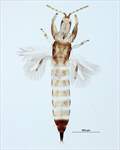
fallax female

picturatus female

picturatus

picturatus antenna

fallax

picturatus metanotum & pelta

picturatus prosternites

picturatus male sternites
Generic diagnosis
Medium-sized, macropterous Phlaeothripinae with unusually broad maxillary stylets. Head longer than wide, vertex without long setae or with 2 pairs of short capitate setae; maxillary stylets retracted to eyes and close together parallel in middle of head. Antennae 8-segmented, III with 2 sense cones, IV with 4 sense cones; VI usually broadly truncate. Pronotum with 5 pairs of major, capitate setae, or with only epimeral setae developed. Prosternal basantra absent, ferna transverse, mesopresternum complete, metathoracic sternopleural sutures long. Metanotum reticulate, with 10-16 small setae but no major setal pair. Fore tarsus with long tooth in both sexes. Fore wing parallel sided, without duplicated cilia. Pelta triangular with apex truncate or bell-shaped; tergites II–VI each with 2 pairs of sigmoid wing-retaining setae, these are small on VII; tergite IX setae shorter than tube, tube shorter than head. Male sternites III–VI with pair of transverse reticulate areas, VIII with no pore plate.
Nomenclatural data
Asemothrips Hood, 1919: 83. Type species Asemothrips picturatus Hood 1919, by monotypy.
Apart from the four Australian species, one further species from Sumatra is listed in this genus (ThripsWiki, 2022).
Australian species
Asemothrips combustipes (Karny, 1920: 41)
Asemothrips fallax (Bagnall, 1924: 629)
Asemothrips finlayi (Girault, 1927: 1)
Asemothrips picturatus Hood, 1919: 83
Relationship data
This genus is of doubtful relationships, and the five listed species are not neccessarily closely related to each other. It is possibly related to Holothrips in view of the relatively broad, and elongate, maxillary stylets, but Apelaunothrips species also have rather broad stylets.
Distribution data
The Australian species have been found at various sites in the eastern States, between Renmark in South Australia and Badu Island in the Torres Straits.
Biological data
The species of this genus have been found only rarely, but have usually been beaten from dead leaves where they presumably feed on fungi.
References
Mound LA (1974) Spore-feeding Thrips (Phlaeothripidae) from Leaf Litter and Dead Wood in Australia. Australian Journal of Zoology 27: 1–106.
ThripsWiki (2022) ThripsWiki - providing information on the World's thrips. Available from: http://thrips.info/wiki/ (Accessed 15.iii.2022)